|
DLI 8400 Ultra-Mobile Rugged Tablet
Ultra-mobile rugged tablet computer
(by Conrad H. Blickenstorfer, with photography by Carol Cotton)
Laporte, Indiana based DLI was founded in the early 1990s as a manufacturer and reseller of wireless data collection devices. They carry mobile computers, vehicle mounted terminals, handhelds, scanners and rugged ultra-mobile tablets like the DLI 8400 examined in this report.
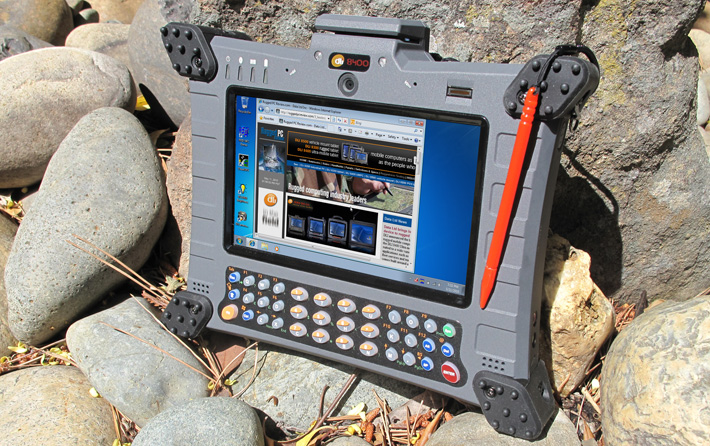
The DLI 8400 represents a type of mobile computing device that we always felt makes a lot of sense—a rugged UMPC (Ultra-Mobile PC). Measuring a very compact 9 x 7.3 x 1.6 inches (and a bit more with the bumpers and other protrusions) and weighing a bit over three pounds, the DLI 8400 is powered by an ultra-efficient Intel Atom processor running at 1.6GHz. Depending on its intended application, the DLI 8400 can be configured with a variety of Microsoft operating systems (Windows 7, XP Pro, XP Tablet Edition, Embedded Standard) or Ubuntu Linux, and run on either a 60 or 80GB shock-mounted hard disk or an industrial SSD with capacity up to 64GB. Two powerful Li-Ion battery packs provide excellent battery life (up to nine hours) between charges.
Our review unit came with a polarized resistive touchscreen for indoor/outdoor viewing (a digitizer is available). The 7-inch display has a strong 350 nit backlight and offers WSVGA (1024 x 600 pixel) wide-format resolution. There are three USB 2.0 ports, an RS232 serial port, an SD Card reader, gigabit Ethernet, a biometric reader, and a pass-through connector to a cradle. Also available are an integrated Honeywell Adaptus Imager, an integrated 3-track magstripe reader, RFID, SiRFstarIII GPS, 802.11a/b/g/n WiFi, Class 2 Bluetooth, dual 2-megapixel cameras (front and back), VoIP, and various WWAN radios supported by Verizon, AT&T, Sprint, and T-Mobile.
A unique design
With its 7-inch wide-format display, integrated keyboard and prominent bumpers, the DLI 8400 is quite unique. In size it is somewhere between a conventional Tablet PC slate (they usually have 8.4 to 10.1-inch displays) and smaller handhelds/UMPCs with integrated keyboards, such as the DAP Kinysis 8900KS or the SwitchBack, both from Roper Mobile. There are some rugged tablets with 7-inch displays (such as the MobileDemand T7000 or the Logic Instrument FieldBook), but they do not have full integrated keyboards. As is, the DLI 8400 is meant to be held in both hands, sort of like a giant Blackberry.
In terms of size, while the DLI 8400's footprint is about that of a modern netbook, which means small, it is not tiny. This is absolutely a real computer as opposed to a technology demonstration or novelty. Small tablets and notebooks often have miniature connectors that you need special cables and adapters for; that is not the case with the DLI 8400. All ports are full-size and standard. And while small computing devices often have small batteries, DLI gave the 8400 more battery power than many full-size notebooks have.
The design of this machine is detailed and elaborate without being playful in a Sony kind of way. The housing is made of a matte-gray ABS+PC polymer that's very tough, highly resistant to impact, and not prone to getting scratched. The design of the case is elegant and purposeful, manufacturing and finish of very high quality. No chrome, trim or exposed metal here; the only homage to fashion is a glossy black display bezel. The most notable design element, of course, are the four very prominent rubber bumpers on each corner that provide a good degree of additional protection. There is no navigation diamond or touchpad although the cursor can be controlled via the elaborate keyboard beneath the display.
Looking at all sides of the DLI 8400
The composite picture below shows the DLI 8400 from all sides. Here you can see the prominent rubber bumpers that protect and secure the computer. If you feel you don't need them, remove them and you have a much handier (albeit less well protected) device that feels a good deal smaller.
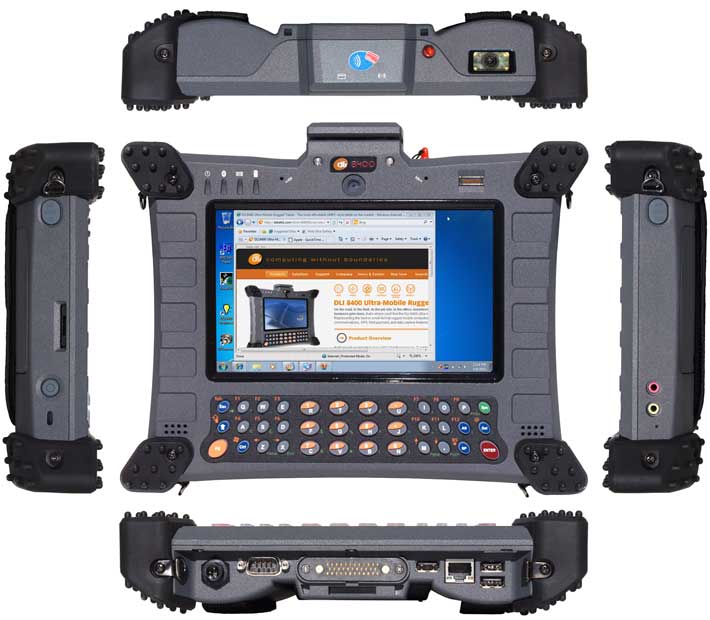
Most of the connectivity is concentrated on the bottom, with the ports facing down. Here you find:
- 3 standard-size USB 2.0
- A standard RJ45 gigabit LAN jack
- A standard DB-9 RS232 serial port with +5 Volt on pin 9
- A waterproof power connector that securely locks onto the power jack by a half-twist of the bayonet lock. This means the power cord will never come off when it's not supposed to.
- A surface mount 35-pin pass-through dock connector with two RF antenna pass-throughs.
On top of the unit you find the integrated 3-track, single-head OPOS/JPOS-compliant mag card reader, the garage for the bright orange stylus, and the window of the optional integrated JPOS-compliant Adaptus imager.
On the left side is a slightly recessed, spring-loaded SD Card slot that in our tester contained a microSD card adapter. There is also a scanner trigger button and a Kensington hardware lock slot.
On the right side is a second scanner trigger button, and standard 3.5mm headphone and microphone jacks.
The two pictures below show the DLI 8400 from the back. On the left side is the unit with its dual batteries installed and both Velcro handstraps as well. The straps make it much easier to carry the computer with one hand, either left or right. Also note the centrally located camera lens.
The picture to the right shows the device with its protective bumpers and dual batteries removed. Note the SIM Card slot in the left battery compartment.
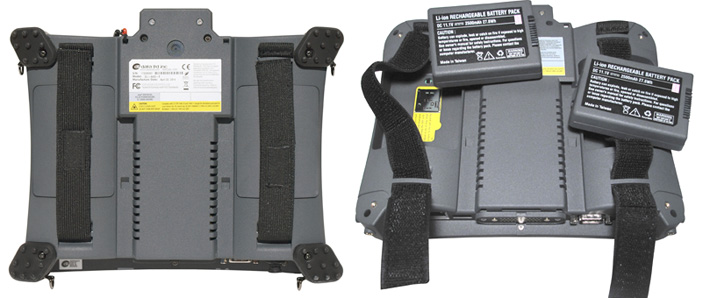
Cradles
While light and ultra-mobile machines like the DLI 8400 are designed to be carried around and used while on the job, fact is that they'll also spend a lot of time in vehicles or in offices. Hence the need for a good dock. Our evaluation unit came with the optional Desktop Cradle that replicates the three USB ports and the RJ45 LAN jack. The device securely snaps into place and can even be locked.
The image below shows the DLI 8400 strapped into the Desktop Cradle from a variety of angles. The same basic design is used for the Vehicle Cradle. There are numerous mounting possibilities, and the pass-through antenna ports mean that wireless communication will never be interrupted as the computer is inserted and removed from the cradle.
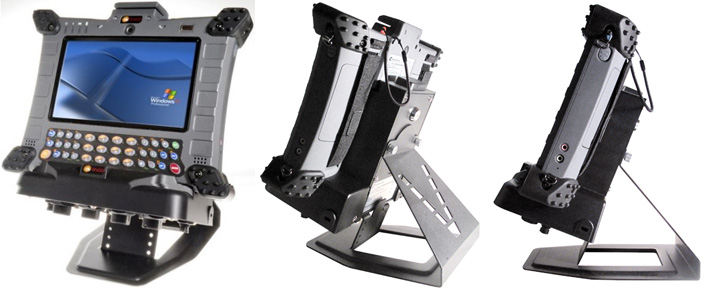
Ruggedness
The DLI 8400's tough appearance with those big rubber bumpers has "rugged" written all over it, and the company stresses resistance to dust, water, drops, vibration and extreme temperatures. As stated, the computer's ABS/PC housing feels extremely solid and trust-inspiring.
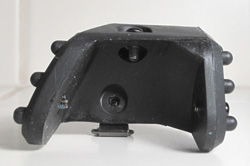 The 8400's large rubber bumpers give the unit both its characteristic and unique look, and also very substantial additional protection. Rubber bumpers are the simplest and often most effective guard against not only damage from drops and other impact, but also against scratching, scoffing and such. A lot of thinking went into these bumpers ranging from the four screws that attach the bumpers very securely to the unit while still making them easily replaceable, all the way to the unique design with individual rubber knobs, sort of like what you find in a massage brush. The design also allows for easy mounting of a carry strap which can go on each of the four sides of the unit. About the only comment I'd have is that I'd have preferred to see steel bumpers with the rubber vulcanized onto it, like I recently saw on another device in our lab. Such bumpers are more stable and easier to screw on. The 8400's large rubber bumpers give the unit both its characteristic and unique look, and also very substantial additional protection. Rubber bumpers are the simplest and often most effective guard against not only damage from drops and other impact, but also against scratching, scoffing and such. A lot of thinking went into these bumpers ranging from the four screws that attach the bumpers very securely to the unit while still making them easily replaceable, all the way to the unique design with individual rubber knobs, sort of like what you find in a massage brush. The design also allows for easy mounting of a carry strap which can go on each of the four sides of the unit. About the only comment I'd have is that I'd have preferred to see steel bumpers with the rubber vulcanized onto it, like I recently saw on another device in our lab. Such bumpers are more stable and easier to screw on.
DLI performed a variety of MIL-STD-810F/810G testing. The DLI 8400 carries a 4-foot drop spec which presumably indicates that it passed the MIL-STD 810G Method 516.6 Procedure VI "Drop" test that includes 26 drops to concrete on each face, edge and corner from 48 inches. It also passed environmental tests for shock and vibration. DLI points out that the tests were done with a hard disk version (some manufacturers quote results performed with optional solid state disks).
As far as sealing against the elements goes, the DLI carries an IP54 ingress protection where the "5" means the unit is protected against dust and guards against the accumulation of harmful deposits, and the "4" means the machine is protected against water spray from all directions, although limited ingress is permitted. It is clear that complete waterproofing was not a design goal here; the connectors and jacks do not have additional rubber plugs, and the SD card slot does not have additional sealing either. So keep in mind that the permitted "limited ingress" should be kept at an absolute minimum.
The -4 to 140 degree Fahrenheit operating temperature range is exceptionally wide. This means that the DLI 8400 can be used in just about any situation, including cold storage and freezers.
Powered by Intel Atom
The DLI 8400 is based on Intel's Atom processor architecture. Intel introduced the Atom platform a couple of years ago as an optimized solution for devices that did not require Intel Core processor performance or simply needed a processor solution that generated less heat and used less battery power. Intel successfully met its goals, and Atom processors have been hugely popular and a hit for Intel, with millions of Atom-powered netbooks sold, and the chip being used in a growing number of vertical market devices. So let's take a look at Atom's background.
In an attempt at fending off growing criticism over its rather average mobile processor offerings, Intel's goals for the Atom were low power consumption and low cost while still delivering adequate (or, as is often used, "targeted") performance. To achieve that, the Atom platform was an entirely new design that allowed Atom chips to require much less power than even the slowed-down ultra-low voltage mobile versions of Intel's Core processors. There is the inevitable trade-off, of course. In order to preserve power and keep costs down, most Atom chips only have one core and instead use HyperThreading, an older Intel technique that uses two threads while increasing power consumption by only about 10%.
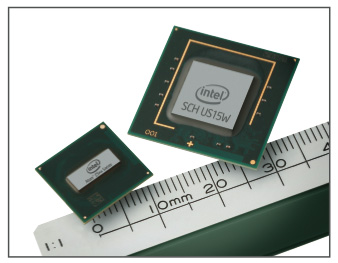 Atom processor architecture is fairly simple (if any processor with its millions of transistors can be called simple) but includes a wealth of power conservation features. A special bus mode minimizes power needed to transmit data to the processor. During periods of inactivity, cache is flushing cache data to system memory. Other Intel power conservation modes were improved and a new standby mode can essentially shut down the processor. Combined, these measures can result in greatly reduced overall power consumption while still providing acceptable performance. Atom processor architecture is fairly simple (if any processor with its millions of transistors can be called simple) but includes a wealth of power conservation features. A special bus mode minimizes power needed to transmit data to the processor. During periods of inactivity, cache is flushing cache data to system memory. Other Intel power conservation modes were improved and a new standby mode can essentially shut down the processor. Combined, these measures can result in greatly reduced overall power consumption while still providing acceptable performance.
The Z530 processor used in the DLI 8400 is part of the original Z5xx family of Atom processors, codenamed "Silverthorne" (see Intel brochure on the Z5xx). DLI chose the original 13 x 14 mm package version as opposed to the "large footprint" "P" version with a 22 x 22 mm package size. Intel targeted the Silverthorne chips at mobile internet devices (MIDs), but they have also become quite common in rugged mobile and embedded devices. The Silverthorne processors use the "Poulsbo" System Controller Hub that was developed specifically for the Z5xx Series. The chipset—which supports PCI-E, SDIO, DDR2, LVDS, ATA 100, LPC and more—uses only about 2.3 watts, which means the total power consumption of the CPU and chipset combined isn't even 5 watts. That is only a small fraction of what a conventional Intel notebook processor and chipset uses. And the Poulsbo chipset even has hardware support for H.264 and other HD decoding (see Intel brochure on the "Poulsbo" US15W SCH).
Fuel sipper
One of the primary selling points of the Intel Atom processor architecture is its minuscule power consumption. In the past, however, we've come across Atom-powered devices that did not seem to make full use of the Atom's various power savings modes, with the result that power draw was much less impressive than it should have been. How well does the DLI 8400 take advantage of its miserly chipset?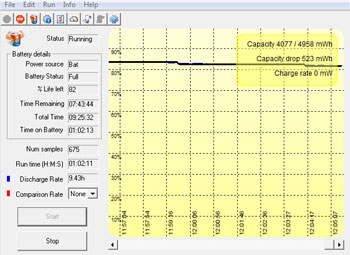
The answer wasn't easy to come by as our standard power draw benchmark, Passmark's BatteryMon, somehow showed capacity as an obviously wrong 5000mWh (instead of the actual 55.6 watt-hours) with a discharge rate of around 500mWh as opposed to the expected 5-7 watthours.
However, in real life, the DLI 8400 is a star in the power consumption department. When you don't need it, it simply goes into stand-by with apparently minuscule power needs. A quick push on the power button and you're right back where you left off. Used this way, after seven hours of runtime, the battery was still at 53%! After 9.5 hours it was at 47%. After a full 12 hours of using the 8400 and then letting it do its own thing, the battery was still at 37 percent. I am so used to walking away from a computer just to then find it dead when I need it that this is a revelation. Left on overnight, the system simply went into hibernation. The next morning it resumed where it left off within seconds, and was still at 20% battery life.
This means that unless you use the DLI 8400 constantly, it can very easily last through a full shift and considerably more if it isn't continously used (which is hardly ever the case anyway).
What this means is that DLI did a superb job putting the 8400's Atom processor's power management and inherently low power consumption to good use. Their comment when asked? "A lot of effort was done to consume the least power possible. The Atom is capable of going into low power states and we took advantage of it." The company's estimate of seven to eight hours of battery life seems achievable.
Performance
Being so incredibly frugal with power, how fast is the DLI 8400? Based on our benchmark library of Atom Z530 systems, we expected the machine to feel about as fast as a standard consumer netbook (which are based on a different family of Atom processors) and its relative performance compared to most full-size rugged tablets on the market to be at about the 60-65% level.
We used Passmark Software's PerformanceTest 6.1 that runs about 30 tests covering CPU, 2D graphics, 3D graphics, memory, and disk and then computes scores for each category and an overall PassMark score. For comparison, we're listing RuggedPCReview benchmark results for devices with different versions of the Z-Series Atom processor, the Atom N270 used in millions of first generation netbooks, the Celeron M in a direct competitor, and also the Intel Core Duo U2500 that is still being used in several current standard-size tablet computers.
|
PERFORMANCE COMPARISON
|
DLI
|
RMT
|
Logic Instrument
|
Panasonic
|
GD-Itronix
|
Winmate
|
|
Model
|
DLI 8400
|
Switchback
|
FieldBook
|
H1 Field
|
Duo-Touch 2
|
I80
|
|
Processor
|
Intel Atom Z530
|
Celeron M
|
Intel Atom Z530P
|
Intel Atom Z540
|
Intel U2500
|
Intel Atom N270
|
|
CPU Speed
|
1.60 GHz
|
1.00 GHz
|
1.60GHz
|
1.86Hz
|
1.20GHz
|
1.60Hz
|
|
Thermal Design Power (TDP)
|
2.3 watts
|
5.0 watts
|
2.3 watts
|
2.4 watts
|
10.0 watts
|
2.5 watts
|
|
CPU Mark
|
234.9
|
236.3
|
235.5
|
275.4
|
631.1
|
162.7
|
|
2D Graphics Mark
|
63.2
|
142.4
|
84.6
|
115.7
|
164.4
|
212.3
|
|
Memory Mark
|
211.0
|
179.7
|
224.4
|
242.7
|
240.6
|
224.0
|
|
Disk Mark
|
199.3
|
163.8
|
266.4
|
284.8
|
318.8
|
382.5
|
|
3D Graphics Mark
|
40.9
|
64.7
|
9.8
|
10.1
|
101.4
|
81.3
|
|
Overall PassMark
|
155.0
|
156.6
|
170.3
|
191.9
|
312.6
|
200.2
|
The benchmark figures do and do not reflect what we expected from the DLI 8400. They do show where Atom Z530-based systems fit in in general, what the performance difference is between Atom processors with different clock speeds, how Atom "Silverthorne" systems compare with Atom "Diamondville" systems, and how Atom systems compare with a Celeron M and the Core Duo U2500. In essence, Atom-based systems deliver netbook performance, which makes them suitable for a wide variety of tasks, albeit not generally for heavy duty multimedia and such. They cannot meet the performance level of Core Duo-based systems such as those equipped with the popular 1.2GHz Core Duo U2500
Note that benchmarks are only an approximate indicator of performance, and that they can yield unexpected or misleading results when different processor architectures are being compared. However, after having conducted many hundreds of benchmarks in the RuggedPCReview.com lab, we found that the bottomline is usually a good indication of a system's actual overall performance.
In real live usage, the DLI 8400 feels amazingly quick and responsive, and it can handle most jobs. However, Atom processors do have definite performance limits, so those with specific performance requirements must ascertain that an Atom-based system can handle their target applications. Particularly interesting were the DLI 8400's graphics benchmarks. The benchmarks seemed lower than expected in 2D graphics test, but very significantly higher in 3D benchmarks. Unlike most Atom-based systems, the DLI 8400 was able to run 1080p video flawlessly. That is quite an accomplishment. Inquiries with DLI on how they did it yielded a "Graphics were enhanced by design tweaks; details are confidential." Fair enough, but great job on HD playback!
Storage
Our DLI 8400 review unit came with a 4,200rpm 60GB Toshiba MK6028GAL hard disk. This is a 1.8-inch design with a Parallel ATA interface that's generally used in space-constrained applications. The MK6028GAL has an almost unbelievable 300,000 hours mean time to failure, which is almost 35 years.
The disk assembly weighs only over three ounces and uses very little power (around one watt while reading or writing, about 0.4 watt while idle). It operates silently. Its lower operating temperature limit of 41 degrees Fahrenheit, however, would appear to limit the 8400 to the same value. It is, however, rated at -4 degrees Fahrenheit, so DLI may be using a disk heater. The DLI 8400 can also be ordered with an 80GB hard disk or Solid State Disk (SSD) storage with 8, 16, 32, or 64GB capacity.
Wireless communication
For wireless communication, the DLI 8400 can be equipped with pretty much whatever it takes to stay in touch either via voice or data, and it also includes a variety of wireless data capture methods.
For WiFi, 802.11b/g/n is standard. If 802.11a support (operating on the 5GHz band) is required, 802.11a/b/g/n is optionally available. Both modules are Cisco CCX5 compatible.
If wireless wide area network (WWAN) support is needed, DLI can ship the 8400 with an optional integrated cellular card that includes support for external antennas and can be used with all major cellular carriers (Verizon, Sprint, AT&T, T Mobile).
For short range wireless networking, Class 2 Bluetooth is available.
Voice communications is available via VoIP (Voice over IP) and can be used either with the integrated dual microphone or with a headset/microphone.
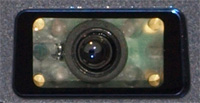 If there are barcode scanning needs, the DLI 8400 can be ordered with an integrated JPOS-compliant (JPOS is a platform for electronic payment) Honeywell Adaptus imager. The Adaptus imager engine essentially combines a digital camera, powerful illumination and scanner aiming optics (crosshairs) in a package small enough to easily fit into compact tablets such as the 8400. If there are barcode scanning needs, the DLI 8400 can be ordered with an integrated JPOS-compliant (JPOS is a platform for electronic payment) Honeywell Adaptus imager. The Adaptus imager engine essentially combines a digital camera, powerful illumination and scanner aiming optics (crosshairs) in a package small enough to easily fit into compact tablets such as the 8400.
One of the characteristic design elements of the DLI 8400 is its integrated magstripe reader. It is a 3-track, single-head unit that is OPOS/JPOS-compliant and gives the 8400 the kind of mobile Point of Sale (POS) processing capabilities that are often required in hospitality, transportation, entertainment, etc., where workers can capture information encoded on cards while walking around rather than scanning cards at a fixed location. This means faster processing, less waiting, and therefore savings and higher customer satisfaction.
Also optionally available is an integrated 13.56 MHz RFID reader that's compatible with the ISO/IEC 14443 A/B spec for proximity cards, with ISO15693 (longer range reads) available as well.
A SiRFstarIII chipset with internal active patch antenna provides GPS functionality.
Dual integrated 2-megapixel cameras
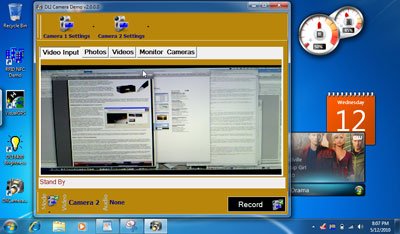 The DLI 8400 can be equipped with not just one, but two integrated 2-megapixel cameras. Why two? Because if a camera is needed for video conferencing, it must be pointed towards the user. If its purpose is documentation, the camera must be mounted on the backside of the tablet, so that the display can be used as a viewfinder. The DLI 8400 can be equipped with not just one, but two integrated 2-megapixel cameras. Why two? Because if a camera is needed for video conferencing, it must be pointed towards the user. If its purpose is documentation, the camera must be mounted on the backside of the tablet, so that the display can be used as a viewfinder.
Our eval unit came with two cameras, both centrally mounted, one in front and one in back. Both have autofocus, and both are UVC-compliant (i.e. they can do streaming video and video conferencing). Note that Windows 7 does not come with even a basic camera utility (such as the "Scanners and Cameras" utility in Windows XP) that allows taking pictures or video and controlling exposure settings and such. For that, you'll need one of the dedicated camera utilities or software that supports the integrated camera.
DLI includes a camera demo utility that can switch between the front and the back camera, record still and video, and show both cameras at once. For the most part, custom software will be used to make camera functionality available.
Very nice 7-inch display
The DLI 8400's LCD is pleasant to work with. Since we didn't take the unit apart, we don't know who supplies the display and what its exact technical specifications are. As is, in every day use the display feels neither too large nor too small for the size of the device. Likewise, the 1024 x 600 pixel resolution feels just about right. I often have trouble adjusting to a large screen with low resolution or a tiny one with very high resolution.
I also like the surface treatment of the display. Today's inexplicable epidemic of "gloss" screens had rendered many a device more suitable for use as a mirror and perhaps watching the occasional video than for actual work. The 8400's display is on the matte side, but it isn't matte enough to swallow up all the light. Another pleasant aspect of this screen is its viewing angles. Horizontally, it's pretty much 180 degrees. Vertically, it's a bit less, but still better than most standard displays, with very little of the chromatic shifts that make many LCDs almost unreadable as you tilt them. As a result, you don't constantly have to adjust the DLI 8400 when you use it.
Like most tablet computers, the DLI 8400 is going to be used outdoors where the display must be viewable and readable under a wide variety of lighting conditions. Even though the display's maximum backlight brightness is just 350 nits, it feels like more than that (a standard notebook display maxes out at around 200 nits).
The first picture below shows a mid-afternoon outdoor comparison between an Acer Aspire One netbook and the DLI 8400. The Acer netbook has a slightly larger screen, but shares the 8400's 1024 x 600 WSVGA resolution. The DLI 8400 display is a bit brighter and completely lacks the Acer's reflectivity thanks to very effective anti-glare coating. The picture also shows the foolhardiness of having a glossy bezel around a display. The DLI 8400 doesn't have that problem, although its narrow bezel is actually a very glossy black that reflects. Make it matte, please.
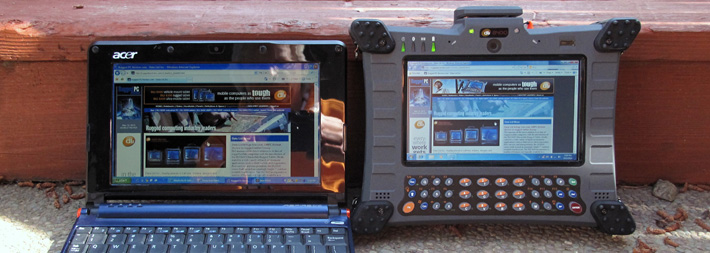
The second picture, taken at an angle on a bright afternoon, dramatically shows the wisdom of equipping a mobile tablet with good anti-glare coating. The DLI remains very readable, with just a bit of the milky diffusion matte screens have to contend with. The glossy Acer becomes completely unreadable.
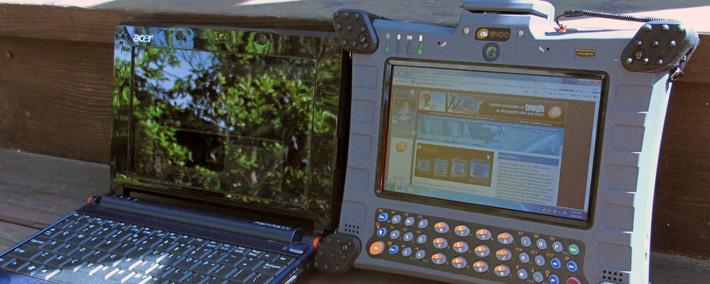
The third picture below shows the inherent different of using a transmissive display indoors and outdoors. Even though the picture on the right was taken in a bright room with lots of daylight, the display's strong backlight makes for a very bright picture. Take the machine outdoors, however, and face it towards the sun and it's a different story. No backlight is a match for the sun, and so it's the display's reflective qualities that preserve a degree of viewability. Also note that dust and fingerprints become much more visible.
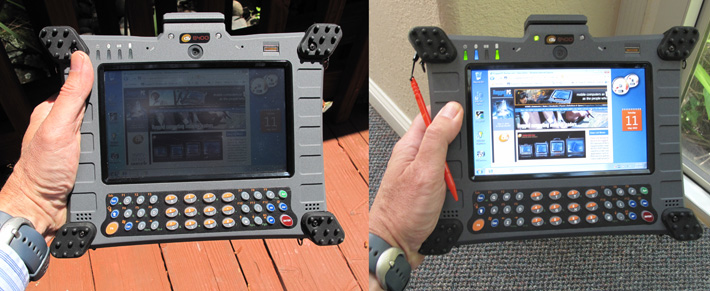
The DLI 8400 shares one modern problem with millions of netbooks: its 1024 x 600 pixel wide-format resolution sits smack between the old 800 x 600 pixel SVGA and 1024 x 768 XGA standard 4:3 aspect ratio standards. A lot of software screens and websites are still optimized for one of those two formats, and so it often feels as if part of the display is cut off. There's a fix for that by switching the 8400 to interpolated 1024 x 768 mode. The display won't be as crisp and things are a bit out of proportion, but it does the trick. Likewise, if you have a problem with the fairly high resolution on a smallish 7-inch display, Windows 7 lets you change it to 125% magnification. This means text and pictures are larger, but you have to scroll more.
The picture below shows the same website in standard magnification 1024 x 600 pixel mode (left), and using Windows 7's 125% magnification mode at the same display resolution.

Digitizer
The DLI 8400 can be ordered either with a resistive touchscreen or an active digitizer. Our test unit had the resistive touchscreen, that can either be used with the supplied and tethered 4-1/2-inch orange plastic stylus or with a finger. It's configured with the PenMount Control Panel that includes three primary settings screens:
Calibrate handles touch calibration using 4, 9, 16, or 25 points, with 25 points offering the maximum accuracy. In advanced mode you can opt to show calibration data.
Setting lets you select either mouse emulation mode or click-on-touch, enable a beep sound to occur on pen down or pen up (or both), and even set its frequency and duration. I am not sure how that would be used, but in noisy vehicle operation, having auditory feedback to confirm a touch operation may come in handy. You can also engage a cursor stabilizer to eliminate cursor jitter, and you can set how the digitizer should handle right clicks.
Edge compensation determines how the digitizer acts along the perimeter of the display where it is sometimes hard to accurately control the cursor.
Below you can see the three PenMount configuration screens.

While the DLI 8400's resistive touch panel works well (and especially so with the stylus), it does not allow taking full advantage of the many Microsoft and third party pen utilities that were all designed for use with an active inductive digitizer that is optionally available on this machine. The 8400 does come with the Microsoft Input Panel where you can enter text with the onscreen keyboard or with either a free-form or combed handwriting input window. Ink goes on quite well, and there is little of the hesitation often seen in touchscreens that can interfere with recognition. This is good because potentially very valuable utilities such as Microsoft Journal all rely on the smooth flow of ink.
So while the DLI 8400's resistive digitizer works well for screen navigation, those who require ultra-smooth ink or cursor tracking (the cursor following the tip of the pen hovering above the display) should go for the active digitizer option. Ideally, a dual input panel option that supports both active pen and touch would be available as an option as well.
Integrated keyboard and other data entry methods
Being a UMPC type of tablet computer, the DLI 8400 does have an integrated physical keyboard, albeit a somewhat unusual one. Placing a full QWERTY keyboard beneath a 7-inch display poses some serious design challenges. While it is relatively easy to thumb-type on a Blackberry or similar thumb-type device, the DLI 8400 UMPC is much wider and so the designers of the unit came up with a novel approach that splits a spillproof membrane keyboard into three thirds, with the center third being the numeric keypad and somewhat wider. The layout itself is standard QWERTY, but the center keys are larger and have different spacing to make numeric data entry as quick and easy as possible.
While the 8400's keyboard is definitely not for touch typists or otherwise conducive for extensive typing, it does work, one does get used to it, and it offers all the functionality needed, including 12 function keys and all the usual special keys. It might have made sense to include some sort of trackpad or trackstick to move the cursor while typing. As is, it's either touch or cursor control keys.

The pictures below show some of the onscreen data entry methods. The gray onscreen keyboard is a DLI utility that closely mimics a standard physical keyboard. Microsoft's standard Windows 7 input panel that includes a comprehensive onscreen QWERTY keyboard can be toggled between modes to show standard F1-F12 function keys. The soft keyboard, however, requires the stylus and does not work well with touch (unless you use a fingernail).
The input panel also includes (shown on the right) two versions for handwritten input, one free form (top right), and one combed with individual boxes for each symbol (bottom). All applications work with these soft keyboards.

Additional pen functionality
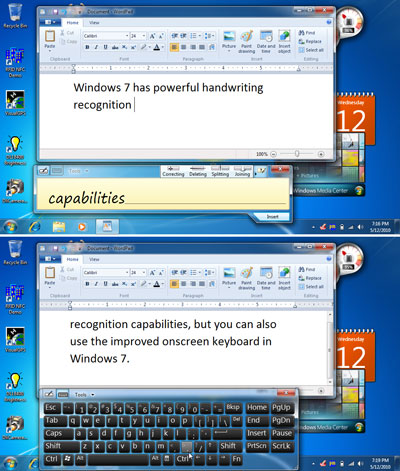 Any device equipped with a touchscreen offers potentially very useful additional functionality that is not available on a standard computer. That includes very flexible navigation and operation via tapping, and it also includes handwriting recognition, a technology that has seen its share of negative press (mostly based on unrealistic user expectations) but actually works quite well. Any device equipped with a touchscreen offers potentially very useful additional functionality that is not available on a standard computer. That includes very flexible navigation and operation via tapping, and it also includes handwriting recognition, a technology that has seen its share of negative press (mostly based on unrealistic user expectations) but actually works quite well.
First introduced in the original Windows XP Tablet PC Edition, the Microsoft Input Panel, in a somewhat improved version, remains part of Windows 7. Using it requires some practice, but it offers good handwriting recognition support. The recognizer can be used with its defaults, but it can also be trained to learn specific styles of handwriting and how to recognize whatever characters or words the recognition engine has problems with.
In order to take full advantage of a tablet computer such as the DLI 8400, users will want to install some of the freely available utilities and applications specifically developed for pen and touch input. Microsoft itself offers the free "Experience Pack for Tablet PC" for download. It includes games and demonstrations, but it is unfortunately only available for the XP Tablet PC Edition.
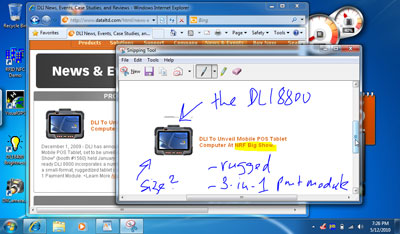 However, a utility that I've always found very useful, the "Snipping Tool," is included in Windows 7 (albeit buried under "Accessories"). With Snipping Tool you can capture a screen shot of anything on your screen (pictures, documents, part of a webpage, etc.). However, a utility that I've always found very useful, the "Snipping Tool," is included in Windows 7 (albeit buried under "Accessories"). With Snipping Tool you can capture a screen shot of anything on your screen (pictures, documents, part of a webpage, etc.).
You can then add handwritten annotations and comments, using different line types and color. You can also use a highlighter in different colors to draw attention to whatever is important. When you're done snipping and annotating, you can either save the file into a special snipping tool editor for further processing, you can print it, or you can even email it.
Snipping Tool is perhaps one of the most useful utilities on a tablet device like the DLI 8400, and I found myself using it a lot.
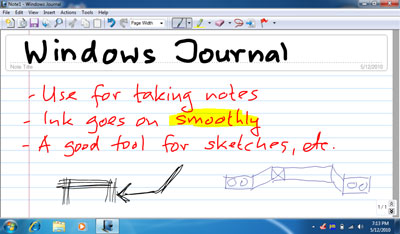 The 8400 also comes with Microsoft Journal, an electronic notepad that, depending on your style of work, can be a very useful productivity tool. Journal lets you write notes in electronic ink, do drawings, convert handwritten notes to text, email your notes, and so on. As with the Snipping Tool, there are different size and color pens, highlighters and also an eraser. The 8400 also comes with Microsoft Journal, an electronic notepad that, depending on your style of work, can be a very useful productivity tool. Journal lets you write notes in electronic ink, do drawings, convert handwritten notes to text, email your notes, and so on. As with the Snipping Tool, there are different size and color pens, highlighters and also an eraser.
The software described represents just a few examples of handy tools available for touch and pen-based systems like the DLI 8400. There are many more, both utilities and full applications, and they can add a lot of functionality on top of what is available in the standard operating system.
Do keep in mind that some of these utilities are optimized for touch or a stylus whereas others work best with an active digitizer. The availability of certain applications may help you decide between touchscreen or active digitizer.
Summary
The DLI 8400 is a rugged ultra-mobile tablet with an integrated keyboard suitable for a wide variety of field service, mobile payment, first responder, fleet management and similar applications. Measuring about 10 x 8 x 2 inches (with bumpers) and weighing a bit over three pounds, the DLI 8400 is significantly smaller and lighter than full-size rugged tablets but it is still large enough to serve as a full-function computer. Its 7-inch touchscreen (digitizer available) with 1024 x 600 resolution (1024 x 768 interpolated available) is small, but large enough to be useful. There is good wired connectivity on board, all connectors are standard size, and there is a wealth of wireless and data capture functionality.
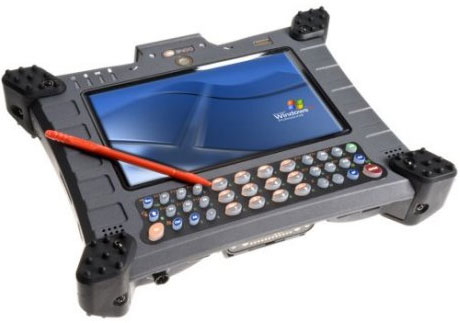 Powered by a 1.6GHz Intel Atom Z530 processor, the DLI 8400 provides a balance between good performance and very long battery life, thanks to the exceptionally low heat dissipation of the processor all without the need of a fan. The device feels quick and responsive in most situations, is capable of flawless 1080p HD video playback, and the dual batteries (55.6 watt-hour combined) easily lasts the 8.5 to 9 hours quoted. Powered by a 1.6GHz Intel Atom Z530 processor, the DLI 8400 provides a balance between good performance and very long battery life, thanks to the exceptionally low heat dissipation of the processor all without the need of a fan. The device feels quick and responsive in most situations, is capable of flawless 1080p HD video playback, and the dual batteries (55.6 watt-hour combined) easily lasts the 8.5 to 9 hours quoted.
The 7-inch display is bright and very sharp, and offers good outdoor viewability without any glare. The resistive touch screen works well and is highly configurable. Electronic ink goes on smoothly enough for drawing and handwriting recognition, though some may prefer the optional active digitizer. The integrated QWERTY thumb-type keyboard is very flexible, but requires some getting used to.
Given its small size and weight, the DLI 8400 has good onboard connectivity with three USB ports, serial, Gigabit LAN, integrated laser scanner, RFID, cameras, and fingerprint scanner, as well as additional connectivity via the optional dock. For onboard storage expansion there is a externally accessible SD card slot. A SIM slot resides underneath one of the batteries.
The DLI 8400's very cleanly designed ABS+PC Polymer housing feels very solid. Combined with the prominent rubber bumpers, this tablet computer should be able to withstand most accidents and exposure to the elements in the field. IP54 sealing means making sure there is not too much exposure to water, especially since ports and slots do not have additional sealing or plugs.
With the 8400 Ultra-Mobile Rugged Tablet, DLI offers a very competent and highly configurable ultra-mobile tablet that can run Windows 7 or several other operating systems. It's smaller and lighter than standard-size tablets, has most of the features and performance, but is much more compact and offers exceptional battery life.
-- Conrad H. Blickenstorfer
DLI 8400 Specs:
| Type |
Rugged ultra-mobile Tablet PC (fanless design)
|
| Processor |
1.6GHz Intel Atom Z530 with 512KB L2 cache and 533MHz FSB |
| Display Chipset |
Intel "Poulsbo" System Controller Hub US15WP |
| Video |
Intel Graphics Media Accelerator 500 (Intel GMA 500) with 3D graphics (integrated in US15WP) |
| OS |
Windows XP Pro, Windows 7 Pro, Windows 7 Ultimate, Windows Embedded Standard, Windows Embedded Standard 7, Windows POSReady 2009, Linux 2.6 (Ubuntu) |
| Memory |
2GB DDR2 SO-DIMM 533MHz |
| Display |
7.0" WSVGA 1024 x 600 pixel Sunlight readable TFT, 350 NIT |
| Digitizer |
Touchscreen or active digitizer (standard or polarized)/1 |
| Keyboard |
35-key backlit QWERTY or numeric keyboard + 2 barcode scanner trigger keys |
| Navigation |
Stylus, touch |
| Storage |
8-64GB industrial SSD or 60/80GB shockmounted 1.8-inch HD |
| Expansion slots |
1 SD Card, 1 SIM |
| Housing |
Impact-resistant ABS+PC polymer |
| Size |
9 x 7.3 x 1.6 without bumpers; 10.1 x 8.2 x 1.95 with bumpers |
| Weight |
3.35 lbs. as tested with two batteries and bumpers |
| Operating temperature |
-4° to 122°F (-20° to 50°C)
|
| Temperature/humidity |
MIL-STD-801G, Method 507.5 |
| Ingress protection |
IP54 |
| Altitude |
15,000 feet operating per MIL-STD-810G, Method 500.5, Procedure II |
| Drop |
Multiple 4ft to bare concrete |
| Shock= |
Operating -40G, (11ms), Crash -75G (11ms)
|
| Salt Fog |
NA |
| Vibration |
5~500Hz 1G PTP, MIL STD. 810F 514.5C-3 Highway truck
vibration exposure |
| EMI/EMC |
FCC Class B, CE |
| Power |
Dual 11.1V 2,800mAH Li-Ion 31.1 Whr Li-Ion packs, total 62.2 watt-hours ("6-7 hrs of usage") |
| Interface |
3 x USB 2.0, RS232, 2 x 2-mp camera; optional: RFID, biometric reader, mag stripe reader, integrated Adaptus barcode scanner |
| Wireless options |
802.11b/g/n WiFi, 802.11 a/b/g/n, Bluetooth Class 2, SiRFstarIII GPS, various WWAN radios (optional integrated cellular card incl. support for external antenna; Verizon, AT&T, T-Mobile)
|
| Warranty |
Standard 1 year; available no-fault service coverage |
| Price |
Starting at US$1,795 |
| Website |
DLI |
| Brochure |
 DLI 8400 DLI 8400 |
| Contact |
1-219-362-1759 or 800-526-1299 tollfree |
(copyright 2010 RuggedPCReview.com)
|



